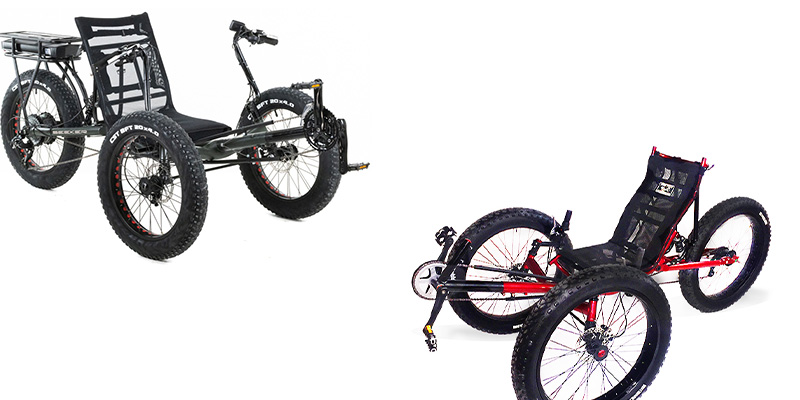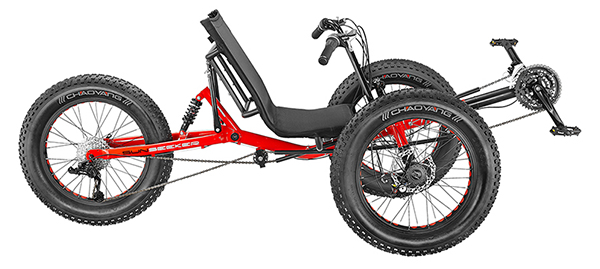

Is a Fat Tire Trike the Right Trike For You?
Ashley Guy - Published on 09/18/2024
Choosing a fat tire trike depends on your specific needs, preferences, and the conditions you plan to ride in. Fat tire trikes, with their wide tires and robust frames, offer unique advantages but may not be ideal for every rider or environment. Here are some factors to help you determine if a fat tire trike is right for you:
1. Terrain and Riding Conditions

Off-Road or Rough Terrain: Fat tire trikes are designed for rough or uneven surfaces, such as gravel, sand, snow, and mud. If you plan to ride on trails, beaches, or other unpaved surfaces, a fat tire trike may be a great fit. The wide tires provide increased traction and stability, making them better suited for off-road adventures.
Urban or Paved Roads: If most of your riding will be on smooth, paved roads or bike paths, you may not need fat tires. Regular trikes or bikes with narrower tires may be more efficient and faster on pavement, as fat tires can add rolling resistance, slowing you down on smooth surfaces.
2. Comfort and Stability
Extra Stability: Fat tire trikes offer extra stability due to their wider tires, making them great for riders who prioritize balance or who may have mobility issues. The wide tires distribute weight more evenly and reduce the risk of tipping, especially on uneven surfaces.
Comfort: The large, low-pressure tires act as natural shock absorbers, making rides over rough terrain more comfortable by minimizing bumps and jolts. If comfort is a priority, particularly on rough paths, a fat tire trike can provide a smoother experience.
3. Weather Conditions
Snow and Ice: Fat tires excel in snow, slush, and icy conditions. If you live in an area with frequent snow or cold weather, a fat tire trike can give you the traction needed to ride safely year-round.
Wet and Muddy Conditions: Fat tires can handle wet or muddy environments, providing more grip than traditional tires. If you frequently encounter these conditions, the extra width and tread of fat tires will give you more confidence and control.
4. Riding Goals and Style

Adventure or Touring: If you’re looking for a versatile trike for adventure riding or long-distance touring, a fat tire trike might be a good choice. The increased stability and ability to handle a variety of terrains can open up more exploration opportunities.
Speed and Efficiency: Fat tires are not designed for high-speed riding or efficiency. If your primary goal is commuting quickly or riding long distances on smooth roads, a standard trike or bike with thinner tires may be more appropriate. The added resistance from fat tires can make pedaling more challenging over long distances.
5. Physical Considerations
Rider Weight: Fat tire trikes are often more robust and can support heavier riders. If you need a trike with a higher weight capacity, a fat tire model might be a good fit.
Strength and Endurance: Since fat tire trikes are generally heavier and require more effort to pedal due to the increased tire surface, they can be more demanding to ride, especially on paved roads. If you have concerns about strength or endurance, consider whether you’d be comfortable with the extra effort required, or look into models with electric assist.
6. Electric Assist Options
E-Trikes: Many fat tire trikes come with an electric assist option, which can help reduce the effort required for pedaling, especially when riding over difficult terrain or long distances. If you like the versatility of fat tires but are concerned about the extra effort, an electric fat tire trike could be a good solution.
7. Aesthetic and Personal Preference

Style: Some riders are drawn to the aesthetic and rugged look of fat tire trikes. If you enjoy the style and feel more confident with the extra width and stability, that can be an important factor in your decision.
8. Cost
Higher Price: Fat tire trikes tend to be more expensive than standard trikes due to their specialized design and larger components. Consider your budget and whether the additional features of a fat tire trike are worth the extra cost for your riding needs.
9. Space and Transportation
Storage and Transportation: Fat tire trikes are bulkier and may require more space for storage and transportation. If you need to transport your trike frequently or have limited storage space, you’ll need to consider the additional size and weight.
Our Sunlite bike rack can carry both small tire and fat tire trikes. The Sunlite bike rack can carry trikes with wheels ranging from 16 inches all the way up to 29 inches! These racks help you to bring your trike with you where ever you go.
A fat tire trike could be right for you if you prioritize stability, plan to ride on rough or diverse terrains, or need extra comfort and traction in challenging conditions. However, if you’ll be riding mostly on smooth, paved surfaces or need a lightweight, fast option, a standard trike or narrower-tired option may be more suitable. Ultimately, it comes down to your personal riding needs, environment, and preferences.




